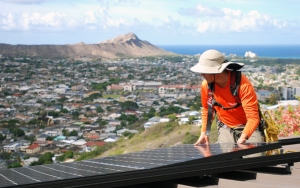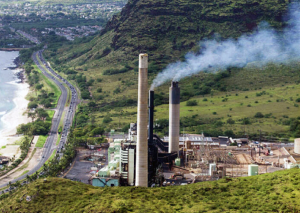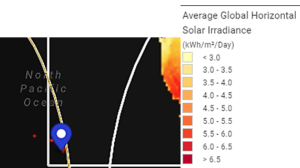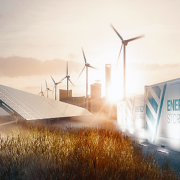Hawaiian Electric; forward into the past
 For the past 10 years, the utility’s transition decisions to renewable energy have been notable, not so much in terms of actions, but in overall inaction. The system has historically worked well, for the most part, but time, technology, and necessity have turned obsolete utility operating assumptions on their head.
For the past 10 years, the utility’s transition decisions to renewable energy have been notable, not so much in terms of actions, but in overall inaction. The system has historically worked well, for the most part, but time, technology, and necessity have turned obsolete utility operating assumptions on their head.
Increased demand for electrical energy is now being accelerated by a growing demand from the electrification of ground transportation. Hawaii in the crosshairs between grand expectations of a clean and self-sustaining clean energy economy, and how best to address the opportunities for change. Front and center is how the state’s largest utility will best address the dual challenges of climate change adaption, and the ever-increasing cost of electricity on household and business budgets. And ratepayers remain in the crosshairs of the state’s largest energy monopoly, Hawaiian Electric, and neverending rate hikes.
Life as a Energy Monopoly
The business, regulatory, and financial structure of public electricity services are by design unique from any other form of commerce. The underlying elements of risk and reward in private sector business ventures are mostly absent for electric utilities like Hawaiian Electric, replaced by income and profit guarantees. Risk, innovation, and cost performance are framed inside a business operation serving as an energy monopoly with publicly guaranteed (by ratepayers) returns on investment in exchange utility guarantees on minimum levels of public service provisioning; electricity delivered on customer demand. This system has worked well for the most part for the last 100 years, but time, technology, and necessity have turned these obsolete utility operating assumptions on their head.
A monopoly is generally defined as limiting available substitutes for its product, engaging in price fixing, and creating barriers of entry for competitors, and is generally illegal within the United States, except in the exceptional case of utilities offering essential public services. Public utilities are regulated by, yes, a state Public Utility Commission, but generally accountable to both state and federal (FERC) oversight, which is not the case for Hawaiian Electric solely bound by state regulation, and SEC regulation as a publicly-traded company.
The system of utility-driven checks and balances has worked well for the most part in the past. but in the case of Hawaii’s energy present and future, have increasingly been called into question. Change is the culprit, and it is evitable, with a looming global climate crisis now in progress, clean energy technology advances that have blurred the line between power consumers and power producers, and pardon the pun, empower consumers to take control of their power needs.
Nobody ever said change is easy, and in Hawaii’s case, isolation from mainland energy suppliers, has placed a decades-old 100% statewide renewable energy (electricity) mandate by 2045 on an uncertain course and outcome.
Hawaiian Electric, for reasons not generally known, now finds itself struggling to balance its past, present, and future operating priorities. And how best to balance those operating priorities firmly rooted in the past with a statewide clean energy mandate, and at the same time supporting traditional profit models, investor expectations, and internal operating priorities focused on extending the life of its legacy investments in old combustion polluting power plants. All this is in the background, while the company faces a new generation of clean energy options and greater customer expectations.
 The utility’s focus on preserving its past stranglehold on electricity production and delivery is already endangered as an increasing number of households and businesses who are taking control of their energy destiny by adopting rooftop solar and battery storage. This consumer trend is driven by several factors beyond cost and energy savings, increasing energy security is a major factor in this transition, reducing grid power essentially to a backup energy source. Efficiency is another major factor favoring this cost-saving and energy-resiliency move by consumers.
The utility’s focus on preserving its past stranglehold on electricity production and delivery is already endangered as an increasing number of households and businesses who are taking control of their energy destiny by adopting rooftop solar and battery storage. This consumer trend is driven by several factors beyond cost and energy savings, increasing energy security is a major factor in this transition, reducing grid power essentially to a backup energy source. Efficiency is another major factor favoring this cost-saving and energy-resiliency move by consumers.
The most efficient energy management outcome is the ability to produce, store, and deliver energy on-demand at the point of consumption, e.g., rooftop solar + storage.
Today’s utility model is not only obsolete; it is also unnecessarily outdated, costly, and energy inefficient. The average loss of power between the power plant and consumers ranges between 5-15%, A challenging service topography, and fragmentation within Hawaiian Electric’s service territory, from transmission to plug, place power efficiency losses on the high end of the scale.
A transition to a clean and sustainable energy economy requires practical and equitable clean energy substitutes for Hawaii’s traditional and unsustainable dependence on dirty and imported fuels required to fuel the state’s outdated and inefficient grid-powered energy delivery system. — goals for the state and compliance with aggressive goals to reduce greenhouse gas emissions and increase the proportion of their energy portfolio produced from renewable energy sources, loosely defined as dirty energy options other than fossil fuels, and clean energy options, e.g.; such as solar and wind and storage.
 In Hawaiian Electric’s own words… “In 2022, solar power provided about 17% of Hawaii’s total electricity, primarily from small-scale, customer-sited solar power generation that is the 10th-highest among the states.”
In Hawaiian Electric’s own words… “In 2022, solar power provided about 17% of Hawaii’s total electricity, primarily from small-scale, customer-sited solar power generation that is the 10th-highest among the states.”
“In 2022, about 29% of the state’s total generation came from renewables.” That so-called renewable energy balance of 12%, was represented by burning toxic trash for power, cutting down trees, burning them to generate electricity, and continuing to engage and expand a geothermal plant, which has consistently failed to meet minimum power generation commitments since the 2018 Kilauea eruption, and advancing a highly questionable biofuel combustion plant agenda.
Nearly all the energy available on Earth is derived from solar radiation, especially in Hawaii. That includes the energy that drives natural processes from wind systems and the hydrological cycle to leaf photosynthesis.
Solar energy and its cousin wind energy have become the most important and cost-effective clean and zero-emissions sources for generating electricity and hot water systems. Today’s battery and hydro-storage systems turn these variable clean energy sources into around-the-clock, reliable, and resilient. energy sources ready to serve all of Hawaii electricity needs.
The state’s largest utility is at a cross-roads, the opportunity for transformation has never been greater. Holding onto an energy past neither serves its customers nor shareholders. It is a path to failure, one increasingly, which will not be subsidized by ratepayers or lost opportunities.




Leave a Reply
Join the Community discussion now - your email address will not be published, remains secure and confidential. Mahalo.